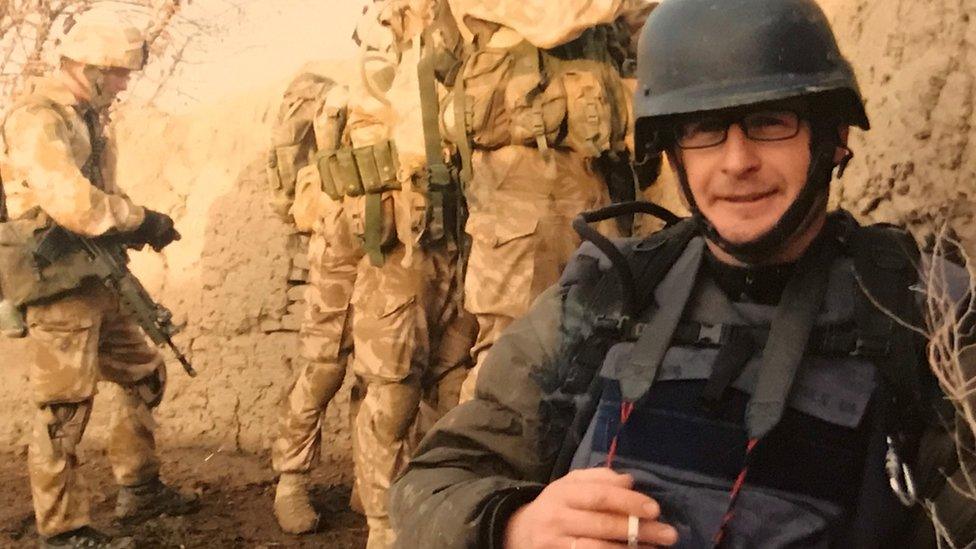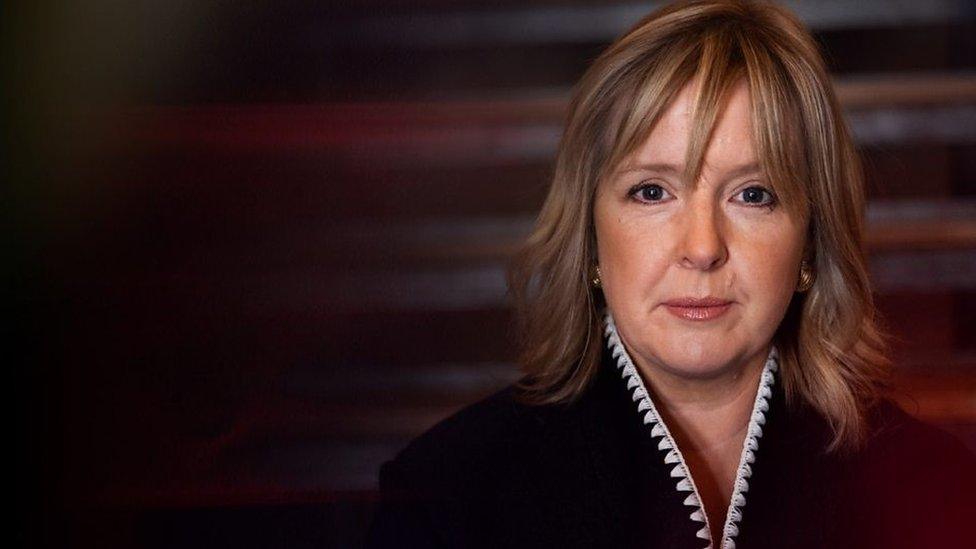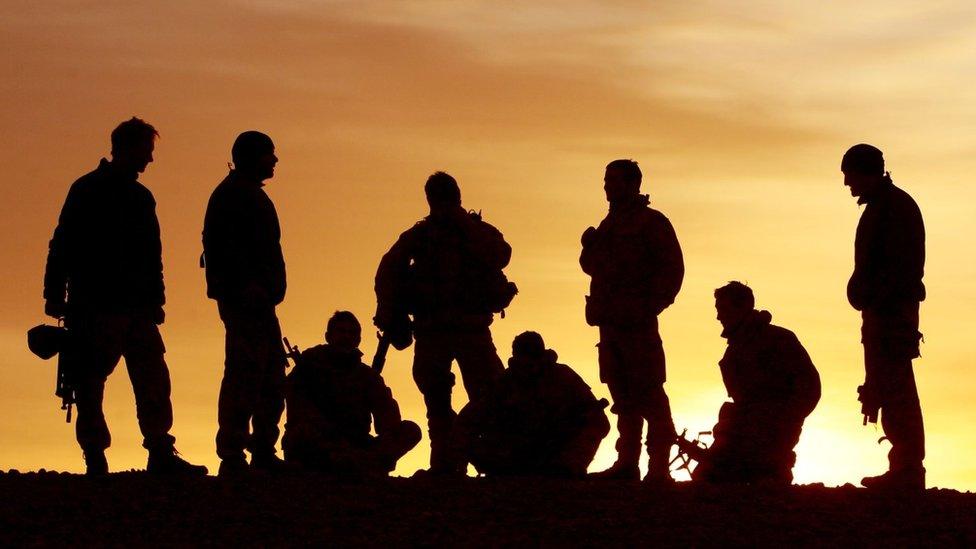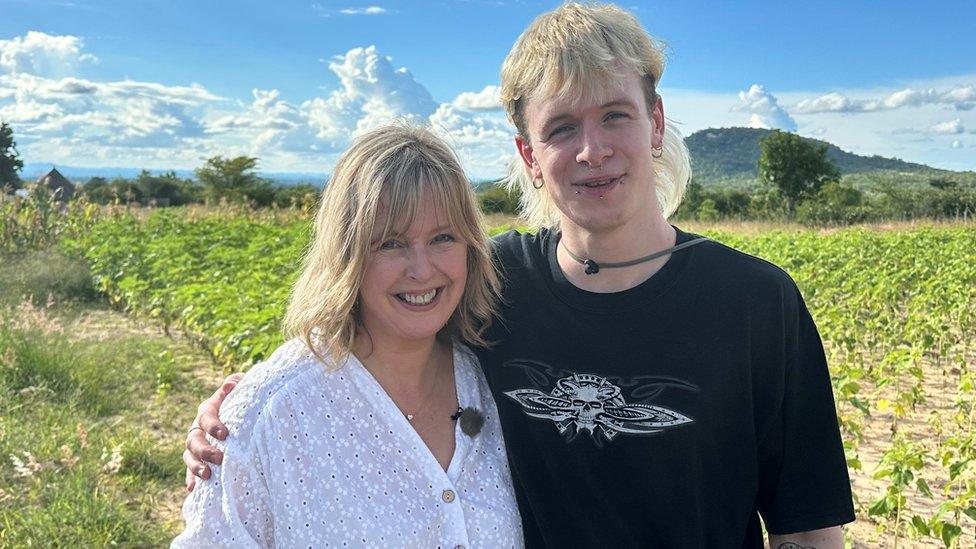Tara Mills reflects on death of brother Richard 15 years on
- Published

As an award-winning photographer, Richard worked in conflict zones in Iraq, Afghanistan, Pakistan and Zimbabwe
On 14 July 2008 my dad called to my house at 07:00. He had a key but it was an unusually early time for him to visit.
I was in the kitchen with my two-year-old son and seven-month-old baby daughter.
"Richard's been killed in Zimbabwe," he said.
As anyone who has suffered the sudden death of a loved one knows, those words never leave you. They remain embedded in your head forever.
Richard had been in the country working on assignment covering the brutality carried out in President Mugabe's regime.
He was my big brother, the middle child of three.
My mum denies it, but he was her favourite.
She is a typical Irish Mammy and would get him his favourite strawberry cornetto if he was hungover. Me and my sister Pamela were told to get up and clean our rooms if we'd had a big night out.
My dad used to laugh when we had custard and ice-cream on a Sunday; it always meant Richard was home for a visit.
He'd left home for England when he was 21 while we stood in tears at Belfast International Airport waving him off.
Any time he came home he caused chaos and soon gained the nickname the Tasmanian Devil. He would sweep in, cause havoc and disappear again.
But we all adored him.
We both shared a love of the news - we were in different countries during the OJ Simpson trial but spent hours on the phone watching it and discussing every detail.
Those were the days before mobile phones and FaceTime.
His path into photojournalism was unusual, fast and very different to mine into broadcasting.
Aged 36, he wanted to change careers and did work experience at the Irish News with their picture editor, the incredibly talented Brendan Murphy, who became his mentor and very close friend.
Emotional ATM that runs out
We initially assumed he'd been killed by Mugabe's men.
He'd photographed several farmers who'd been beaten and had their land taken.
A few hours later a colleague from The Times phoned me to say it was, in fact, suicide.
Breaking that news to my parents and sister was the hardest thing I've ever done.
I remember interviewing the mum of a young woman killed in a road accident. She told me her mind shattered into a million tiny pieces like a big glass ball falling to the ground.
At that moment I knew exactly what she meant.

Like every other family who has lost a loved one to suicide, we will never, ever know why
I also felt the enormity of my parents losing their child and that was the hardest thing to bear.
Richard's son Finn was just five at the time and he was staying with my parents in Belfast while his mum and dad were both abroad working.
My sister and I took him out for the day, went swimming and tried to distract him while desperate attempts were made to bring his mum home so she could be there when he was told his dad was dead.
All the while we tried to piece together the incomprehensible news that he had taken his own life.
It didn't make sense. He was a 6ft 4 ins amiable Irishman who could talk his way into and out of every scrape.
He was the last man standing at a party.
I had a fantastic BBC colleague, the late Seamus Kelters. He was very interested in how trauma affects journalists, having spent a lifetime covering the Troubles, and watching colleagues succumb to depression and alcoholism.
A few years before Richard died, Seamus said to me look out for him.
I replied: "Seamus, don't worry. He's the last one you'd ever have to worry about. He's the life and soul of the party."
Seamus said: "Everyone has an emotional ATM that runs out eventually."
It turns out he was right. Something happened, but like every other family who has lost a loved one to suicide, we will never, ever know why.
The wider impact
And since that time thousands more men and women have taken their own lives.
There are schools across Northern Ireland that have lost more than one pupil to suicide - something that was unheard of in the 1980s and 1990s.
Our decision to make a documentary about suicide did not come easily.
We pondered for months, talked about the impact on our family and friends. But also on wider society.
I've spent years covering suicides as part of my job and I'm so mindful of the impact of reporting and not wanting to contribute to the statistics.
Times have changed in the 15 years since my brother died.
We are more open about how we help grieving families. There are some fantastic organisations out there helping their communities.
Two of them, Steps in Draperstown, and the Derry Crisis Intervention Centre are featured in our film. We also hear from the man who lost his son in 2009, and then almost incomprehensibly, his 13-year-old granddaughter earlier this year.
In nearly every photograph I have of my brother when we were kids, he's making a rude gesture covering his face.
I'm not sure if it was prophetic that Richard would make a career working behind the lens rather than in front of it. Or maybe I was just his annoying little sister.
Across five days he covered a murder, an IRA funeral and talked his way into taking a portrait of then UK Prime Minister Tony Blair who just happened to be at Stormont. He produced an impressive portfolio of work.
Always working
He took that portfolio of pictures and walked along Fleet Street and knocked on the doors of all the broadsheets.
The Times took him on and he became and award-winning war photographer working with some of the best war reporters in the business in conflict zones in Iraq, Afghanistan, Pakistan and Zimbabwe.
He came back to Northern Ireland regularly for the Times. During the Holy Cross dispute in 2001 he arrived to cover the stand-off outside the girls' primary school.

Richard became an award-winning war photographer working in conflict zones in Iraq, Afghanistan, Pakistan and Zimbabwe
I was there working for BBC Newsline. He saw me and dropped his kit, saying: "Here, look after that for me," and ran off to take pictures.
He was rarely in the press pack, he would be taking the photograph from a different height or a different angle.
His motto was: "You're only as good as your next photograph."
He was always working, always striving to take the ultimate picture.
His reporter colleagues were a huge source of support. They told us tales of how during sub-zero temperatures in the Pakistan earthquake, Richard gave a homeless man his coat.
I remember him talking down the fact that when he returned from the trip he had frostbite and ended up with pneumonia.
We also heard how he talked militant Islamist rebels in Somalia into playing a football match when things became tense. And then they raced them in their hire car around an old dirt track.
Many of his photos concentrate on the eyes of the subject - often women and children in desperate times. Sometimes moments of hope in crisis.
He had the ability to connect with those he photographed and he had a chameleon nature where he could quickly blend into the company he found himself in and make friends with those around him.
And although we'll never know why, it doesn't stop us wondering. And sometimes we have to be careful not to drive ourselves mad in the process. Was it PTSD?
Did he empathise so much that his emotional reserves run out? Did he feel too much of the pain of those he photographed?
And so the idea of the film emerged. A journey to Zimbabwe to retrace Richard's final steps and let Finn know more about the dad he has virtually no memory of.
Mostly about Finn
People might ask why, given it's 15 years since he died.
There are several reasons: It's mostly about Finn. He's 20 now and during the documentary we tracked down some footage of Richard talking in a BBC interview in 2003 and thought his voice might jog Finn's memory.

I wanted him to know what his dad meant not just to us but to the wider world.
It's also about my children. They're old enough now to be told what happened and I want them to know about their uncle.
And it's about the family. My parents and my sister. The confusion and disbelief can still stop us in our tracks. Could the people he worked with in Zimbabwe, who saw him the day he died, give us any clues about the why?
It's unlikely we could ever make the trip without the security of a film crew and director. It was tricky even then.
And the director Michael Fanning and the crew have inadvertently become part of our grieving process by making a film that beautifully captures the essence of a man they never got to meet.
I'll be forever grateful that they have helped a young man, who never knew what it was like to have a dad, try to make sense of that.
There is a bigger picture too. I've spoken to hundreds of bereaved families and those who want to be interviewed often say the motivation is to prevent it happening to someone else.
Northern Ireland's suicide rate remains stubbornly high.
People who take their own lives are in terrible crisis. They don't want to die, they just don't want to live the life they have at that moment.
Those moments do pass and when I think of what Richard has missed over the last 15 years, I'm blindsided.
I told my daughter recently that I have thought about Richard every day for 15 years and she looked at me in utter disbelief.
But it's true.
It seems appropriate that during the darkest times it's his photographs and those of him when we were children that give me comfort.
Tara Mills: Life after Loss is available on the BBC iPlayer.
If you've been affected by any of the issues mentioned in this article, please go to BBC Action Line where you can find support